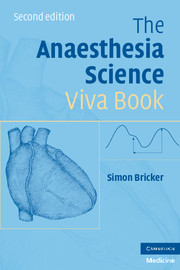Book contents
6 - Miscellaneous science and medicine
Summary
Mechanisms of action of general anaesthetics
Commentary
This has been the focus of fundamental research which this viva will not have time to explore in depth. The subject matter is complex and although selective effects on CNS proteins appear to offer the most complete explanation, much remains unexplained. If you can give a reasonably plausible summary of the main points, then you should have done enough to pass.
The viva
You will be asked about the theories that have been advanced to explain the action of general anaesthetics.
Compounds that cause reversible insensibility range from xenon, which is chemically unreactive and whose structure could not be simpler, to barbiturates and phenols, whose structures are both complex and dissimilar. This makes the search for a unifying theory of action with particular emphasis on a specific structure–activity relationship more difficult.
Meyer–Overton hypothesis: Meyer and Overton (separately) were the first to relate the potency of anaesthetic agents to their lipid solubility. They argued further that the onset of narcosis was evident as soon as the particular substance had attained a certain molar concentration in the lipids of the cell, and that the lipid layers of the cell membrane represented the main site of action. Much early research was based on the hypothesis that disruption of the lipid bilayer affected the function of membrane proteins and mediated an interruption of neuronal traffic. As a unifying theory however, it was undermined by the observations that temperature rises disrupt lipid membranes without inducing a state of general anaesthesia, and that there are many compounds with high lipid solubility which exert no anaesthetic effect.
[…]
- Type
- Chapter
- Information
- The Anaesthesia Science Viva Book , pp. 359 - 404Publisher: Cambridge University PressPrint publication year: 2008



